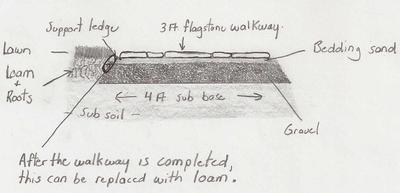Accurately Estimate Patio and Walkway Sub-base Materials
by Kevin
(Calgary)

Picture 1: Cross-section of a walkway with a sub-base excavation.
When I first started gathering material to build this site about 3 years ago, I asked some friends what would be the most valuable information for homeowners to have on this site. One of them who ran a flagstone quarry and also an installation company, now deals directly with landscape contractors in sales.
His response was:
“I'm not sure about the homeowners, but you definitely need to have something on your site about estimating for landscapers. I get calls every day from contractors that have been in the business for years asking me how much product they need”.
This was his personal pet peeve.
So if contractors have a problem doing this, as a homeowner you are not alone.
Each of our how-to modules will have a section on estimating materials if you need help with the formulas. This page will focus on helping you before you get to that stage. (See our Estimating Material Article for full landscaping materials estimation.)
Most people end up short on materials when building gravel bases for patios, walkways, and walls. We are going to look at two advanced tricks of the trade when estimating materials, so you can avoid these same mistakes. After reading these, you will understand why people tend to “under”, instead of “over” estimate.
Tip #1
**Before you read this, please refer to the diagrams at the top so you will better understand what I am talking about. Thanks.**
If you are excavating down into your lawn, there will be adequate support on the sides of your project from the existing soil. (Picture 1). Estimating will be pretty straight forward. You can skip to tip #2.
If you are building your project from scratch (on top of existing soil or earth), than you will have to adjust your estimates. (Picture 2).
If you ordered the same amount of gravel for the sub base for each of these projects based on the surface dimensions, you would be short almost half a cubic yard of gravel in the second scenario. (Based on a 50 ft. walkway with a 6 inch sub base).
The gravel sub base on the second example is actually close to 4 ft. at the bottom, and 3 ½ ft. at the top. There was a loss in width of almost 1 inch, for every 2 inch lift of gravel that was packed in.
A gravel sub base is typically packed in 2 inch layers "lifts" for proper compaction.
During construction of a patio, walkway, or wall, the base needs to provide adequate support for the edge stones of your project. This means the sub base should have a “ledge” that is a couple of inches wider than your planned surface measurements.
If your walkway surface is 3 ft. wide, the base the stones are going to lay on should be 3ft. 6 inches. (3 ft. for the walkway stones, and 3 inches of support ledge on either side.)
You could probably get away with 2 inches, but 3 is recommended.
If you are sodding or seeding up to the edge of the stones, you can remove the gravel later after the edging is installed or the stones are stabilized if you aren't using edging. It can be replaced with packed loam when you install your lawn.
See sketch and messy scribbles (Picture 3).
Why would you do this extra step?
Having a deeper root system will make the grass along the edge more resilient to stresses of winter kill and other factors. I am sure many of you have seen the results of people not having the appropriate soil depth along a walkway or driveway before? This is not the only reason the grass can struggle here, but it sure helps.
So the higher up the project, the wider the base needs to be. I have seen landscapers look at a plan and order sub base material for a 3 ft. wide walkway, that needed to be build up as much as a foot. This could throw off an estimate by hundreds of dollars in materials (depending on the size of the project).
Summarizing
Let's say you have a required base depth of 6 inches of gravel for your sub base. You would actually have to have a lower base width of 4 ft. of gravel to have 3 ft., 6 inches to bed the stones on . This is how a tapered sub base edge works. There will be a loss of roughly 1 inch in width for every 2 inches in base height.
A tapered sub base is a natural progression in building stable layers to ensure you have a support edge. It will also help to accommodate soil for a deep rooting lawn right up the the edge of your project.
So what's the #2 tip for estimating your base requirements?
Compaction
Bases should be packed in layers or “Lifts” of 2 inches for proper compaction. Compaction is the term used to describe what happens when the stones are compressed, vibrated, or tamped. They will take up less room after being compacted then they did in the pile on your driveway.
Depending on the equipment you will be using, this will throw off your estimates as much as 5 to 10%. When you have completed your estimate based on your cubic measurements, you can add an extra 10% to be on the safe side.
So this is my little trick of the trade when estimating a sub base for a stone patio or wall. I hope this helps you with your projects.
Kevin
Dream yard
Check out our time and money saving e-book
How to avoid the biggest mistakes made by DIYers, designers, and landscaping companies.
Visitor
Favorites
Giggles 'n' Thoughts











